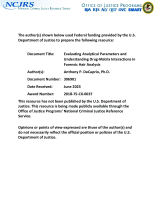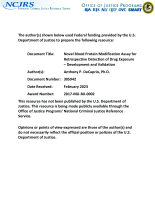Hair analysis
A Novel Method for the Detection of Cocaine in Hair using a Freeze/Thaw Method and GC/MS Analysis
Elucidation of the effect of heat exposure on hair colored by permanent and semipermanent colorants using surface-enhanced Raman spectroscopy
Multi-isotopes in human hair: A tool to initiate cross-border collaboration in international cold-cases
NIJ Awards $16M to Support Forensic Science Research
On September 26, 2023, NIJ announced $16 million in new funding to support 33 projects under the FY23 Research and Development in Forensic Science for Criminal Justice Purposes solicitation. Through this program, NIJ continues to advance the speed, accuracy, and reliability of forensic analysis, which ultimately bolsters the administration of justice.
Funding Highlights for Fiscal Year 2023
Since 2009, NIJ has invested nearly $300 million...




